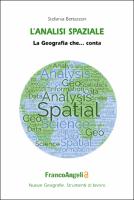L'analisi spaziale
La Geografia che… conta
| dc.contributor.author | Bertazzon, Stefania | |
| dc.date.accessioned | 2022-05-04T14:16:30Z | |
| dc.date.available | 2022-05-04T14:16:30Z | |
| dc.date.issued | 2022 | |
| dc.identifier | ONIX_20220504_9788835139461_24 | |
| dc.identifier | OCN: 1348376307 | |
| dc.identifier.uri | https://library.oapen.org/handle/20.500.12657/54289 | |
| dc.language | Italian | |
| dc.subject.other | Spatial analysis | |
| dc.subject.other | GIS | |
| dc.subject.other | spatial statistics | |
| dc.subject.other | critical spatial science | |
| dc.subject.other | geospatial analytics | |
| dc.subject.other | GIScience | |
| dc.title | L'analisi spaziale | |
| dc.title.alternative | La Geografia che… conta | |
| dc.type | book | |
| oapen.abstract.otherlanguage | The so-called data deluge, along with ever-increasing technological capabilities, tantalizes geographers with exciting opportunities for spatial data analysis. These opportunities come with challenges, because data and technology, alone, cannot address the pressing questions of our world. Spatial analysis, a.k.a. spatial statistics, is a lot more than colourful maps and attractive displays: still relatively underrepresented in the Italian geography, this discipline has grown from a strictly quantitative niche to part of a critical spatial science and continues to stimulate new developments in statistics because, as we know, spatial is special. This book, published in the series “New Geographies. Work Tools”, adds spatial analysis to the Italian geographer’s toolbox. Not a how-to manual, it presents some of the core analytical issues through the redundancy of narrative language and mathematical language. It traces the journey of spatial analysis from its roots in quantitative geography, GIS, and statistics, towards the definition of its own identity and the acceptance of its own relativity and limitations. It discusses the relationship of spatial analysis with GIScience and its efforts to embed critiques within its own discourse, emphasizing the role of theory, the importance of hypothesis testing, and acknowledging the ethics surrounding the use and analysis of data. A few examples illustrate practical implementations, showing the value added by spatial statistics in yielding reliable analyses that can support management decisions. It concludes with a brief outlook on the Italian geographic literature, where spatial analysis – like elsewhere – can play a role in competently accepting today’s opportunities and challenges, in a constructive dialogue within geography as a whole. | |
| oapen.relation.isPublishedBy | e2ddfb5e-9202-4851-8afe-1e09b020b018 | |
| oapen.relation.isbn | 9788835139461 | |
| oapen.pages | 276 | |
| oapen.place.publication | Milan |

